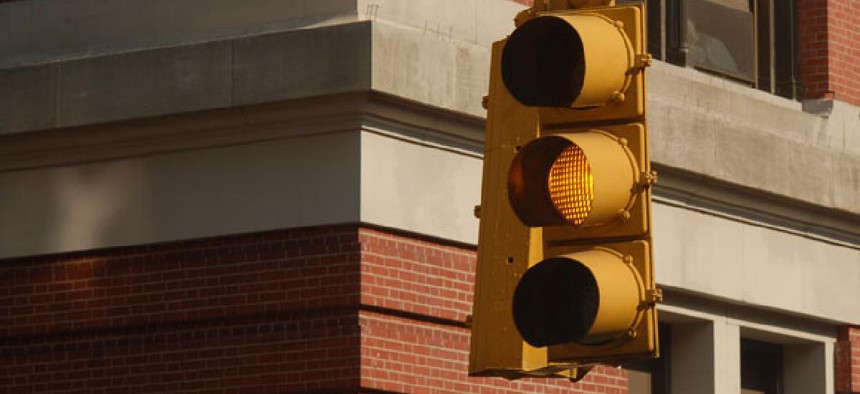
PhotoXpress
Dreaded yellow light may be trap for traffic violations
Activist group claims signals are timed to increase traffic violations.
The National Motorists Association has a warning for the millions of drivers hitting the road for the busy holiday travel season: Beware of the yellow lights.
The timing of yellow lights on traffic signals at many intersections is purposely set to a minimum so more drivers can be ticketed for running red lights, says the 30-year-old activist group based in Waunakee, Wis.
This past summer in New Jersey, the transportation department ordered 21 cities and towns to suspend the use of red-light cameras at 63 intersections because the timing of yellow lights at those locations was below the minimum established by state law.
Other cities—including Dallas; Chattanooga, Tenn.; and Union City, Calif.—have been caught shortening yellow lights in the past decade as red-light cameras have become sources of steady revenue. The cameras snap photos of license plates on any vehicles in an intersection while the light is red, and citations, often carrying fines of $100 or more, are mailed to the registration’s address.
“Cities and for-profit camera companies maximize revenue by setting yellow-light times that are too short,” said National Motorists Association President Gary Biller. “It is a violation of the public trust, and it jeopardizes motorist, cyclist, and pedestrian safety.”
Ironically, slightly longer yellow lights can significantly increase safety by allowing more time for intersections to clear, the group says. Biller cited one study that found just one additional second of yellow time can reduce the number of collisions in an intersection by 40 percent.
Longer yellow lights also greatly reduce the number of red-light violations. A recent Texas study concluded, "Lengthening the yellow light interval by as little as 0.5 to 1.5 seconds decreases the incidence of red-light running violations by 50 percent or more,” Biller said in a Nov. 16 letter to the head of the Federal Highway Administration, Victor Mendez.
The NMA wants the FHWA to mandate minimum national standards for yellow-light duration. Currently, the federal agency offers only “guidance” suggesting that yellow lights should last between 3 and 6 seconds. “There’s an ongoing debate in the traffic-engineering community about what the standard should be,” said NMA spokesman John Bowman.
When New Jersey passed a law allowing red-light cameras in 2008, the Legislature established a formula for yellow-light duration. The minimum yellow time is 3 seconds at intersections where traffic is moving at 25 miles per hour, and the time goes up by a half-second for every 5 mph increase in traffic speed. So for intersections where traffic is approaching at 55 mph, the yellow light must be on for a minimum of 6 seconds.
“This requirement aims to ensure that the traffic signal is timed properly to provide motorists with sufficient time to avoid a violation and fine by entering an intersection when the light is red,” according to the New Jersey Transportation Department.
Chicago has locked in all of its yellow lights to last 3 seconds, even at intersections where traffic is moving at more than 40 mph, Biller said in his letter to Mendez. “It is not surprising that Chicago is able to generate annual red-light camera ticket revenue in excess of $70 million by setting its yellow lights at deficient 3.0 second intervals,” Biller wrote.
Matthew J. Weiss, a New York City lawyer who has built a practice around defending motorists in traffic cases, warns drivers on his blog, “If you see yellow and you are not already in the intersection, hit your brakes.”
But that can be a dangerous practice in some situations, according to Hesham Rakha, a Virginia Tech engineering professor who has conducted studies of driver behavior when traffic signals turn yellow.
At the moment the light turns yellow, every motorist approaching the intersection is suddenly “trapped in a dilemma zone” where an instant decision must be made whether it’s safer to stop or proceed.
“If the driver decides to stop when he or she should have proceeded, rear-end crashes could occur,” Rakha wrote in a study last year for the Virginia Transportation Department. “Alternatively, if the driver proceeds when he or she should have stopped, he or she would run the red light and a right-angle crash with side-street traffic could occur.”
Rakha’s study also found that for the safest decision-making, “in general, female drivers need longer yellow times compared to male drivers. In addition, the age slightly affects the required yellow time, where older drivers need slightly longer yellow times when compared to younger drivers.”
The bottom line for the motorists’ association is that drivers should be given as much time as reasonably possible to decide whether to brake or accelerate on yellow, regardless of what it might do to a city’s traffic-ticket revenues. “Short yellow lights force many responsible motorists to make split-second decisions that can lead to unwarranted traffic tickets, or worse, intersection collisions,” Biller said.
NEXT STORY: Better liked than Congress: David Petraeus






